Why does an orchid rot and how to save it?
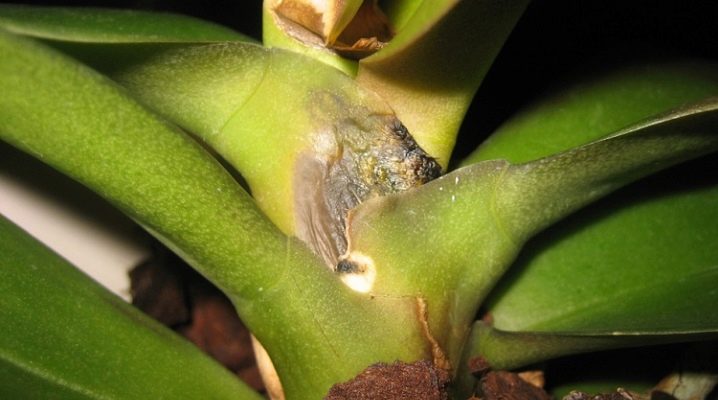
The orchid is extremely popular. It comes from hot and humid countries, but it also feels good on the windowsills of a temperate climate. The plant is very strong and tenacious, but requires proper care and watering. If the conditions are not met, it begins to hurt and rot. How to cure a flower and prevent the death of an exotic beauty?

Causes of decay
Diseases in orchids are divided into three groups:
- infectious;
- bacterial;
- viral.
The first two can be dealt with, but if the flower is infected by some virus, then the plant will have to be destroyed. Sometimes even the most experienced flower growers cannot understand these diseases. The most common disease is heart and leaf rot. They start to deteriorate from the base. Such a place becomes wet or various spots begin to appear. In addition, they note:
- weakness;
- the appearance deteriorates;
- turgor is lost;
- growth stops;
- photosynthesis is inhibited.
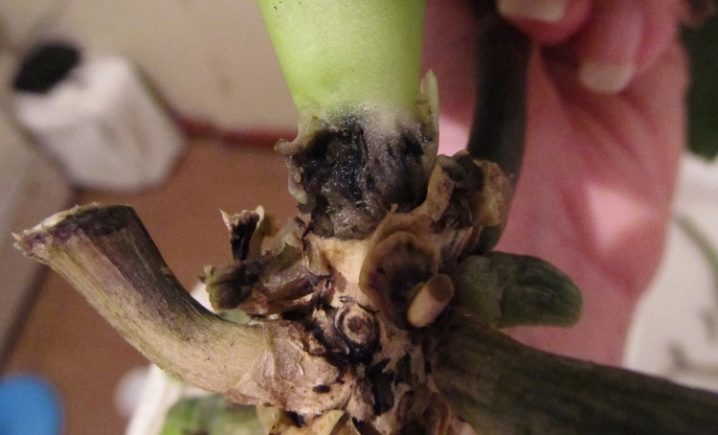
The main thing is a timely noticed deviation and timely correct diagnosis. It is important to understand why this happened. Here are the reasons why the orchid has rotted:
- care errors;
- bacterial infection;
- very dense soil;
- unsuitable fertilizers.
The solution to the problem of improper care is:
- in revising the irrigation system;
- it is worth raising the temperature;
- insufficient humidity;
- transfer.

There are many types of rot, it is necessary to carefully examine the plant and understand which of them hit the flower:
- fusarium - leaves become soft, on which a characteristic bloom of pink appears, and after it marks with pink halos;
- pitium - the leaves begin to rot in the middle, turn yellow and fall off;
- late blight - black or dark brown rot appears, then passes into watery areas;
- wet bacterial - the appearance of dark wet spots on the leaves;
- gray - fungal disease, locally gray fluffy islands appear;
- black - if you keep the plant in a cold room, black spots appear at the base.
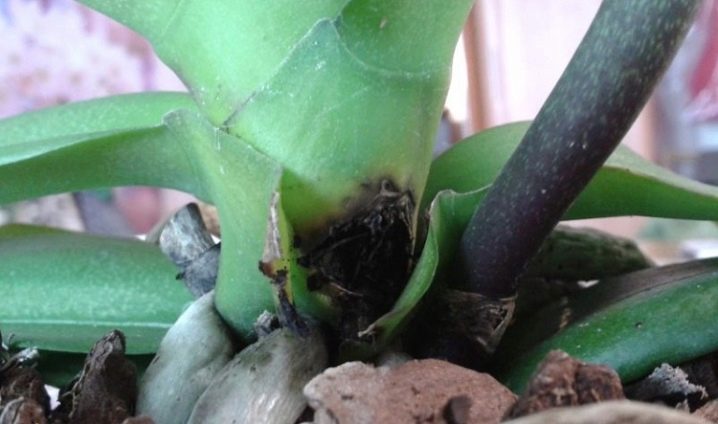
The reasons for the rotting of the orchid may be mechanical damage or frostbite. They damage the beauty with a transplant, a peduncle holder, or simply a flowerpot could be dropped. In such cases, the wounds must be treated with bactericidal substances:
- crushed activated charcoal or charcoal;
- ground cinnamon;
- iodine;
- brilliant green.
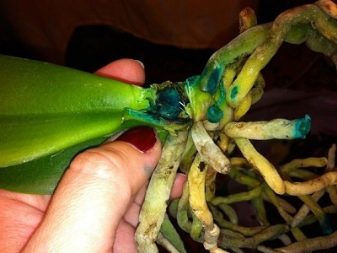
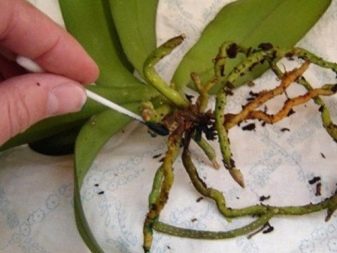
It is possible to frostbite the plant if the wrong watering is carried out during the cold period. Novice flower growers arrange steam baths for orchids with a shower, and then put them on the windowsill. Remaining moisture and currents of cold air create conditions for the core and leaves to begin to deteriorate. This is also helped by poor lighting with a lack of sunlight.
The source of trouble can also be a wet substrate or soil that does not have time to dry out. Since it may be wrongly selected. Unsuitable bark is heavy and dense, poor air circulation occurs in it, and the water here does not have time to dry out.
It is in such a humid environment that all pathogenic bacteria begin to develop, and the flower rots.
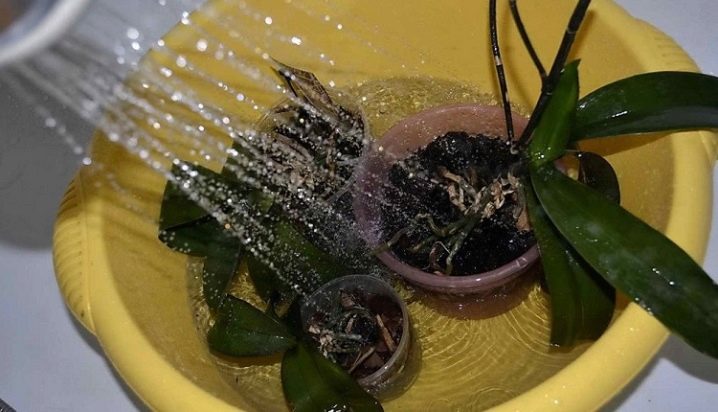
Excess fertilizer can also be harmful, which creates a nitrogen oversaturation that leads to cracking. The flower gradually withers and rots in the presence of various parasites in it, as they skillfully hide.In this case, the hardest thing is to find out who exactly settled in the flowerpot. To find out the type of insects:
- a piece of apple or other fruit is left overnight in a flowerpot;
- the plant is immersed in a container of water.
The most common parasites include:
- ticks;
- click beetle;
- mealy worm.
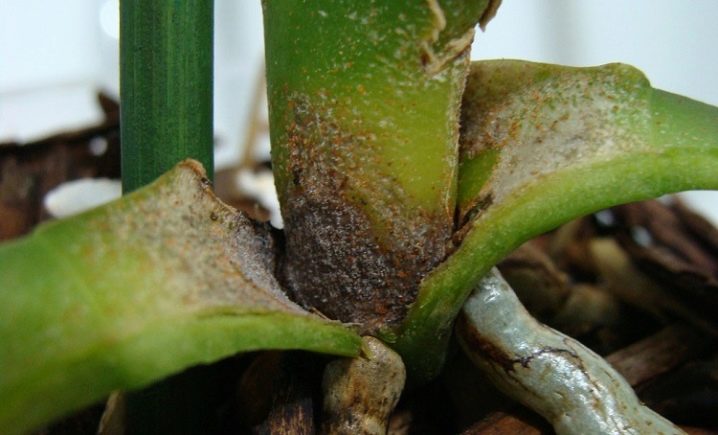
The clicker beetle can come from the street, it feeds on the root system. Therefore, when bringing a new plant into the house, keep it separately to check if there are harmful insects or not. An incorrect diagnosis can lead to confusion between parasite infestation with a fungal infection, anthracnose. With her, the plant dies very quickly if it has low immunity.
If such problems arise, the plant is isolated from others for quarantine, processed. The nearby plants are also examined.
In order not to bring to such a state, acquiring a plant, it is required to study the features of the microclimate, the nuances of care, diseases and ways to prevent them.
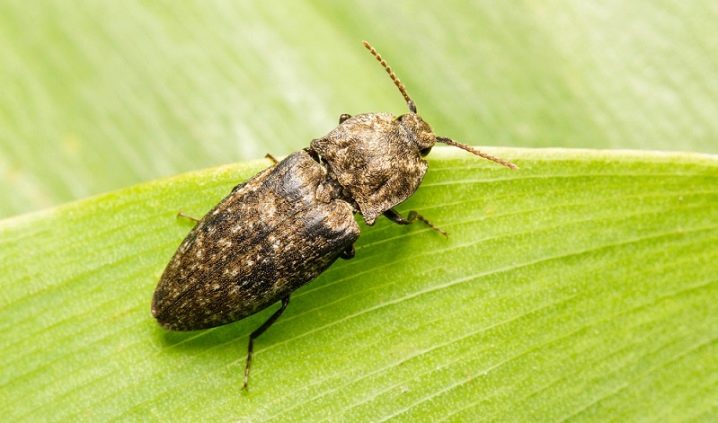
How to save from decay?
Close attention is required if the growth point is rotting, in a different way the core. Since most orchid species are monopodial and belong to the Phalaenopsis group. The growing point is the central part of the plant. Its defeat is very dangerous, since when it dies away, the upper part and roots immediately rot away, there is nothing to do here if the disease has gone very far. Phalaenopsis may die as the flower will no longer grow upward.
At the initial stage of the disease, rotten parts are cut out with a knife treated with a bactericidal agent. Sprinkle with activated charcoal or cinnamon. If the point is not touched, the plant will very quickly start up the top leaf. If the lower leaves have fallen, it means that rotting has begun at the base or neck.
There are no big difficulties in providing assistance in such a situation, you need to take simple, but necessary actions. The flower needs to be transplanted.
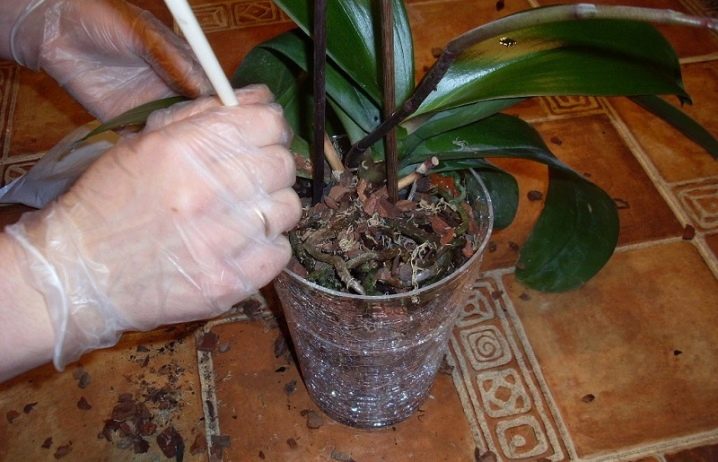
For regeneration and quick recovery, the plant may also need a greenhouse. To do this, you need to cover the flower with a bottle or a bag to create a thermal effect, and foam plastic is placed under the middle of the flower, which will protect the beauty from excessive moisture. To protect the roots, you need to be careful with watering. Its abundance causes rot. In stores, there is a spongy cup inside the flower under the neck, which accumulates moisture. It can also cause damage to the organs of the flower, so at home the orchid needs to be transplanted, remove all excess and fill the flowerpot with sterile soil.
In addition, phalaenopsis can also get heatstroke. In this case, it will turn yellow and lose its tone. In order to revive the leaves, the pot is removed inside the room. During the first hours, he needs rest. After a time, when the plant has cooled down, it is sprayed. It will take several days to recover. Do not put the pot in its original place and try to avoid direct sunlight, which can cause burns.
Orchid treatment is a very slow process and may take 2 to 6 months to recover. Healing is most difficult if the central part begins to deteriorate.
And it is better if this is the beginning of the disease, then the chances of saving the plants are very high.
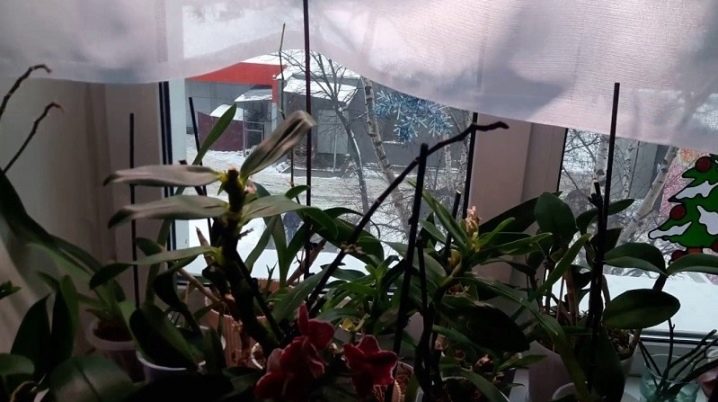
Chemicals
In order to stop the incipient infection and fight the vital activity of bacteria, fungicidal agents will help. It is with their help that diseased plants or soil are sprinkled during transplantation and are well restored. The composition includes compounds:
- aldehydes;
- mercury;
- copper;
- organic matter.
Natural and organic products are highly preferred, as they are effective and, if desired, the treatment can be repeated without harm to the plant and soil. There are many of them on the drug market, it is important to choose the most effective ones.
- Fitosporin - a great defender against fungi and bacteria. They are sprinkled with a plant freed from rot, they can even be added to a new substrate for disinfection.
- Trichodermin - used for prophylaxis. Fights infections leading to decay.
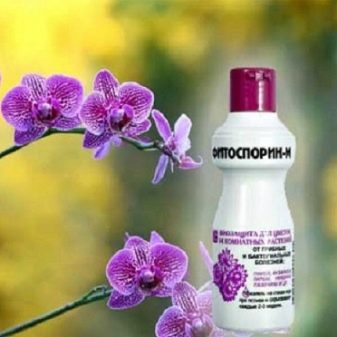

Inorganic drugs are sharper and more effective, but the dosage must be observed here.
- An inorganic compound known as copper sulfate. Used for feeding adult orchids.
- Bordeaux copper-based liquid is used to treat the affected areas. Thus, healing takes place, and the roots are not burned.
Do not forget about nutritional vitamins.
- Succinic acid. It acts as an antioxidant. Neutralizes toxins and strengthens the immune system. The solution is sprayed on the leaves, trunk, peduncle, as well as moss or sphagnum, which is laid over the plant.
- B vitamins strengthen immunity, promote leaf growth and photosynthesis.
Applying the listed means in the care, the treatment of a tropical flower is accelerated.

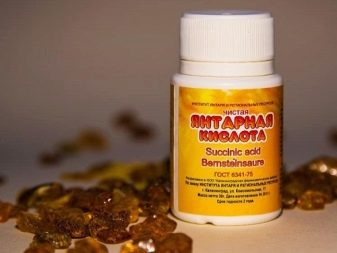
Traditional methods
Do not neglect the advice of traditional medicine, they, too, can be effective in fighting disease.
- Soap solution. Soap or other detergent is taken to treat the entire body of the flower.
- The infusion is made from tobacco. For 1 liter there are 30 g of tobacco, stir, infuse for a day.
- The onion is grated, boiling water is added to it. Then it is infused for 7 hours and watered for 3 days.
A sick beauty needs to choose an effective drug and method that will cure and relieve the problems that have arisen. Such care will be required every day.
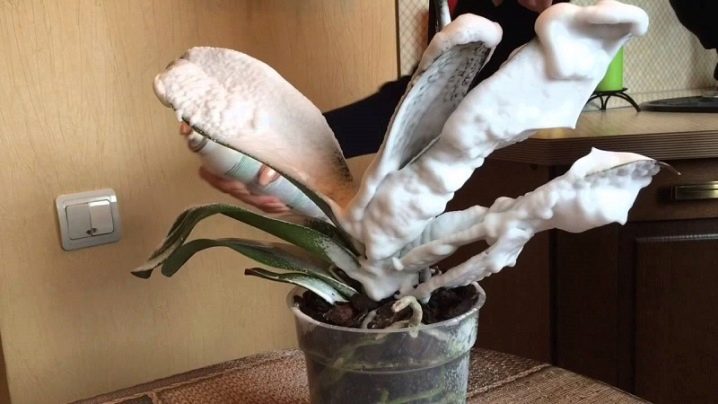
How to transplant an affected orchid?
You need to carefully examine the flower and determine in what condition the neck or base is, and then carefully remove the plant from the flowerpot. Remove the substrate from the roots. The peduncle is cut off. Remove all rotten or dry unwanted parts until healthy tissue. The resulting wounds must be sprinkled with a bactericidal agent, as well as the necessary drug to combat decay and disease.
The orchid is transplanted into a new pot with a clean substrate. It is impossible to water immediately, it takes time. The reanimated plant must be constantly monitored.
The flower must be removed from the sun's rays and monitored in the greenhouse. No watering required.
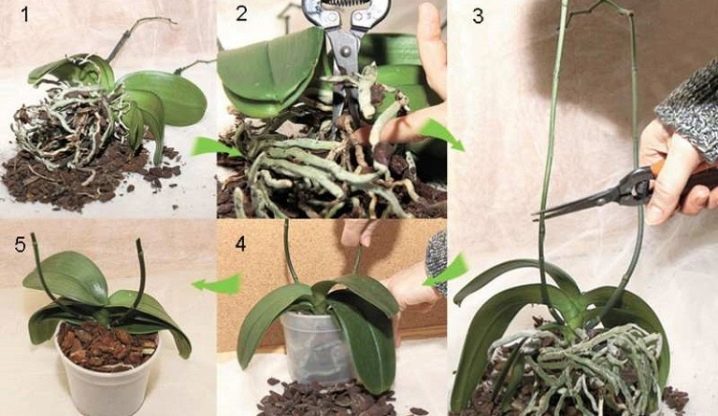
Flower resuscitation
There is a way to save an orchid from a lost growth point. The cleaned plant must be processed and lowered into a vase with water at room temperature, while the upper part should not come into contact with moisture. They are placed in a well-lit place. Unlike processing the core, you do not need to overdo it with cutting off the roots affected by rot, since they may not recover, and new leaves will not grow with them.
The lower part must be tried to be restored. The soft damaged velamen is removed, leaving springy cores, which are called strands. These are the real roots of phalaenopsis, if they are still elastic, then you need to leave their length. If the plant starts to be left without the top, there is no need to wait. The orchid is taken out of the flowerpot, the lower part is examined. A sick flower is placed in a greenhouse, placing a piece of polystyrene and wet moss under it. After the listed procedures, a new root system will appear and leaves will grow again.
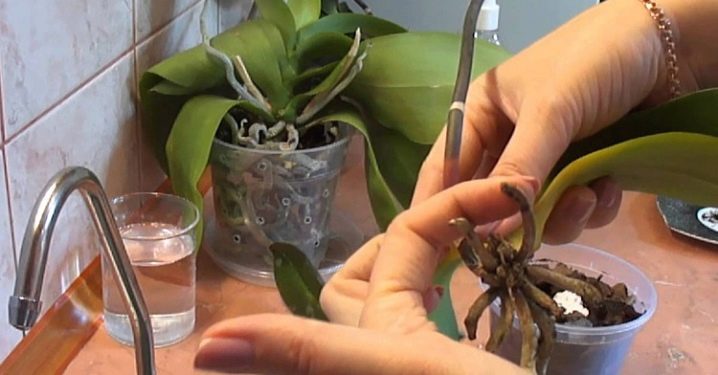
Prevention measures
To protect against diseases, the plant needs to strengthen its immunity. In this case, he is not afraid of many diseases.
- Periodic feeding with mineral fertilizers is required.
- Protect from direct sunlight. Since there is a possibility of burns.
- The room temperature in summer should be + 20 to + 25. In winter, the minimum is +15. The sharp drop should not be 5 degrees.
- Climate humidity should be 50%. The beauty is sprayed or glasses of water are placed next to it.
- Limit watering as much as possible in winter. Need to monitor the condition of the roots and bark. They should be completely dry before the next watering.
- Daily airing of the room is carried out.
- Transplant once every 2 years only into a disinfected substrate.
An orchid requires care, as any violation of "discipline" in the care can lead to the death or long recovery of the plant.

You can find out how to treat wet bacterial rot in orchids below.































The comment was sent successfully.